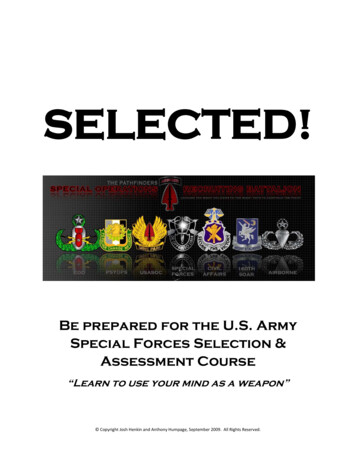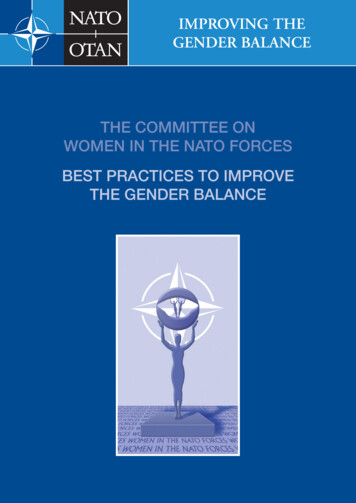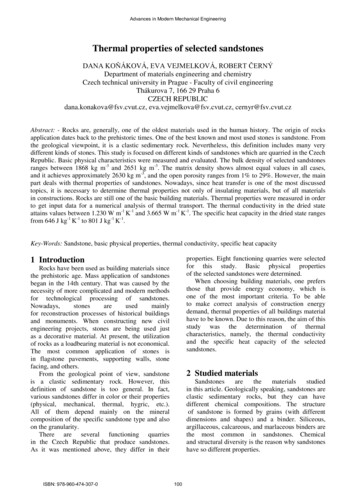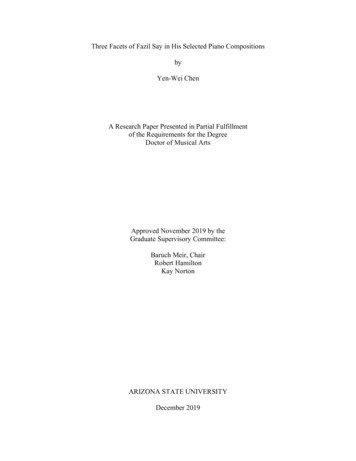
Transcription
SELECTED!Be prepared for the U.S. ArmySpecial Forces Selection &Assessment Course“Learn to use your mind as a weapon” Copyright Josh Henkin and Anthony Humpage, September 2009. All Rights Reserved.
CONTENTSE‐pageIntroduction.3The Selected! Fitness program .6Footcare.32.38Heat acclimatization, hydration and electrolyte management.45Water and electrolyte balance table.53Exercises, Running and Marching: Putting it all together .54Explaining the workouts .Preparation for running tests and rucksack marches.55Fitness program workout schedule.60Run and march workout schedule.61
Introduction.Welcome to “Selected!”. In this program we will be helping you to achieve the standards required toenable you to pass the U.S. Army Selection and Assessment course.“Selected!” consists of a DVD pack and a supporting E‐book. The DVDs and book contain exercises,workouts, training runs, training marches, workout schedules and educational material to betterprepare you for the challenges of the Selection and Assessment course.There are two distinct reasons that applicants might be unsuccessful at the Selection and Assessmentcourse. First, they may be physically unprepared for the challenges of the course. Second, they sufferinjuries – many of which could have been which could have been avoided – that prevent them fromcompleting the course successfully.How to use this course.A very successful Olympic running coach once said that the better prepared athlete would always beatthe faster athlete. We think he’s right. In the US Army Special Forces selection and assessment courseyou may be competing for selection against faster or stronger servicemen. But, if you have completedthis course, done the workouts and absorbed the educational material – and put into practice what youhave learned – you will be one of the best prepared applicants and more likely to succeed.Is this course designed to make you a super‐soldier? No, we have plenty of time for that later. It isspecifically designed to fully prepare you to meet the physical challenges you will face at the US ArmySpecial Forces selection and assessment course, and to avoid or overcome some of the challenges thathave defeated some of those who have gone before you.This course is twelve weeks long. Think of it as a series of coached workouts peaking you for a majorevent. Although you may be tempted to think that more is better, but it is not. Do only the assignedworkouts, and, in order. If you do more, you will harm the positive adaptation, or changes in your bodythat the workouts are designed to bring about. It is an unfortunate scientific fact that your body onlyadapts from exercise when it is resting, not when it is doing. So don’t hurt your chances by trying to addmore workouts to those we have prescribed.
Your coaches.Anthony C. “Woofie” Humpage.Coach Woofie has completed ultramarathons at 50 kilometer, 50‐mile and 100‐mile distances, iron‐distance triathlons (swim 2.4 miles, cycle 112 miles and run 26.2 miles) andorienteering events up to 24 hours in duration. He helps athletes traininjury‐free, stay that way, and successfully compete in extreme ultra‐distance and multi‐day events. A veteran of the Badwater ultramarathonmedical team, Coach Woofie is an expert in performing in hostileenvironments and hydration and electrolyte management. He is a CertifiedStrength and Conditioning Specialist and a USA Triathlon Certified Coach.Josh HenkinJosh Henkin is a graduate of Arizona State University where he received his degree inExercise Science. For the past fifteen years Josh has worked in theStrength & Conditioning field where he has worked withprofessional athletes as well as Navy Seals, S.W.A.T. units, and firedepartments. He has extensive experience working with low backinjuries, hip replacements, and shoulder surgeries.For the past seven years Josh has been owner of InnovativeFitness Solutions, LLC in Scottsdale, Arizona. Besides running his exclusive training center, Joshdeveloped Sandbag Fitness Systems and the Ultimate Sandbag. Sandbag Fitness Systems is the firstsystem to implement a systemized method of implementing sandbag training to the Strength &Conditioning field. His Ultimate Sandbag has quickly gained worldwide notice as the best sandbag on themarket and one of the hottest training tools.His work with Sandbag Fitness Systems and the Ultimate Sandbag has made Josh one of the most soughtout Strength Coaches in the field. Josh has lectured worldwide on his system of training and hiseducational programs have become a gold standard in the industry :"As a Sports Performance Coach and US ARMY Veteran I am very particular when I makean investment in my fitness and training equipment. One thing that I can say is first andforemost is that nothing comes close to the Ultimate Sandbag and YES that even meansthe military issue duffel bags. The stitching on the bags far exceeds military standardsand there was a lot of thought and planning in the design, function, and durability of thisbag. I ordered the "Advanced Package Sandbag and I am enjoying the quality ofinstruction of the "High Octane DVD" and the easy to understand format. Within minutesyou can take a novice and get them results and have them seeing the benefits of
sandbag training. I train mainly women in my "NO BS NYC Boot Camps" and I must saythey are very happy and get a strong sense of self confidence when they do the sametype of workouts that pro MMA fighters or other athletes are doing. If you didn't get thepoint of the mini biography I just wrote basically I am saying the Ultimate Sandbag andHigh Octane DVD package are the best resources to have in your fat loss or performancetraining tool kit. Thanks Josh for putting out a quality product. I will be getting another ina few short weeks. Can you believe my mom wanted the Ultimate Sandbag as aMother's Day present.crazy huh?"Nii Wilson
The Selected Fitness ProgramWorking with tactical athletes is both an honor and privilege. Coaching men and women that putthemselves on the line for us every day is something that should be taken with the utmost focusand attention to detail ourselves.Over the past fifteen years I have worked with all types of tactical athletes; SWAT units,firefighters, Special Forces personnel, and many more. It seemed that many were drawn to theidea of functional fitness that I have always preached. More important than just performingfunctional fitness was truly identifying their needs and providing training that truly addressedtheir needs.What is Functional Fitness?Functional training is a term that has been thrown around as many common “buzz” words. Somemay simply define functional fitness as improving fitness for everyday life. While this simplisticdefinition may be appropriate in some cases we want to be more specific. Functional fitness isthe development of many fitness qualities such as; maximal strength, strength-endurance,mobility, flexibility, power, speed, and agility to allow for enhanced performance for specificdemands. In the end, functional fitness for the tactical athlete means training that improves theirperformance in the field.This means having the ability to exhibit high levels of strength in light of fatigue andcompromised situations (i.e. lack of sleep, having heavy equipment on, etc.). This also meansbeing able to move efficiently and quickly to deal with a great variety of situations andoppositions. Lastly, functional fitness for the tactical athlete requires them to be resilient to injuryunder all the varying circumstances they may encounter in the field.The demands on the tactical athlete may be the most unique to anyone performing physicaltraining because the situations where their physical fitness may be tested can often be highlyunpredictable and room for error is very low.How to Create Functional FitnessThe tactical athlete faces the challenge of being well rounded in all aspects of fitness. Not onlydo tactical athletes have to be complete, they must be able to demonstrate much of their fitness incomprised situations. That is why the “Selected” program was developed.There are many forms of fitness training and selecting the right methods and tools are vital to thesuccess of any program. Analyzing both the needs and tests that special forces applicants wouldrequire, it was determined that two training implements would be at the foundation of ourprogram. These two tools would be the TRX suspension system and “The Ultimate Sandbag”.
These two training tools each offer some unique advantages for the tactical athlete. The TRXoffers an ability to add both complexity and load to traditional bodyweight movements that arevery familiar in most forms of military training and testing. By being able to load the bodywithout too much weight on the spine we can build strength without risking greater injury. Inaddition, we can make standard bodyweight exercises that many can perform high repetitions oninto maximal strength drills that will challenge the strongest of athletes.Adding complexity also teaches the tactical athlete how to move more efficiently to develop notjust strength, but dynamic flexibility as well which is vital for performance. We will be using theTRX not to just build strength in the common bodyweight movements, but also to strengthenweak links that typically get injured during tactical training.The “Ultimate Sandbag” was designed with hardcore training in mind. For years, tactical athleteshave utilized duffel bags as training devices. However, this homemade sandbag lacks greatversatility and strength. With multiple handle attachments and an easy loading and unloadingsystem, the “Ultimate Sandbag” is designed for over 300 different exercises that challenge thebody as a unit and develops great strength and endurance.What makes the sandbag training so special for tactical athletes is the unstable nature of thesandbag. Utilizing unstable implements requires the use of more muscles and this quickly leadsto greater strength gains and more resiliency to injury. Training with sandbags has long been apreferred method of strength training by wrestlers and martial artists alike.These great athletes realized that sandbags allowed them to train in specific patterns and motionsthat were closely related to their sports. The shifting of the sandbags gave them a chance to trainto the closest thing to a live opponent. This is the very same reason they are such a necessarytraining tool for the tactical athlete.The TRX and “Ultimate Sandbag” are two perfect tools because they also work within thechallenges of tactical preparation programs. In many situations the tactical athlete may be in thefield or lack the perfect training environment. These two tools are highly adaptable to anysituation that the tactical athlete may find themselves in. In addition, these tools are perfect forteam or unit training in groups. They are easy to modify and adjust for varying fitness levels ororthopedic limitations.Common Mistakes in Tactical Athlete TrainingThe tactical athlete should and needs to be trained like any other athlete. The problem with manyprograms set forth by different organizations is they don’t separate the special needs andconsiderations that the tactical athlete possesses. Below is a discussion of some of the mostcommon mistakes that occur in tactical athlete preparation.
Evaluate: Not just the needs of the position, but the current state of the individual. The fitnessand orthopedic health of the individual can vary greatly! A new cadet versus a veteran can bevery different and assessing their current fitness and health are essential starting points. Sincefitness testing may only occur during the entrance period of an organization, fitness may begreatly different for those that have spent considerable time in the field. There is also a need todevelop testing protocols that are relevant to the needs of the job and can be measurable in bothlarge group and individual settings.In addition, we must separate the ideals of training for long-term longevity in the military andtraining for testing. Just as with any athlete these two sometimes conflicting concepts can beblended if proper analysis of both situations are made.Common Injuires: Many of these athletes have common injuries just like any other athlete.Low back injuries, cardiac problems, overuse injuries are areas that need to be addressed by thefitness program. Sometimes the best way to increase performance is to decrease injuries.A Balanced Fitness Program: Although there are many fitness programs that state theydemonstrate balance in their programs, they often overemphasize a single component. Mostoften this is endurance aspect of training and other attributes are missed because of the mindsetof having to “beat up” the tactical athlete. Developing movement skills, flexibility, and strengthin extreme ranges of motion are all important considerations of the fitness program. Yes, I amsorry there will also be a need for both aerobic and anaerobic training.Analyzing Strength: To say someone is “strong” is about as vague of term as one can use.Strength has be relevant to the demands of the sport or job. Many tactical athletes completelyignore vital aspects of strength such as isometric strength that is so important in the properperformance of their job. More time developing certain types of strength can be moreadvantageous for the tactical athlete both because of the combative side of the job as well as thetime spent in specific postures.Recovery: The most challenging part of working with tactical athletes is the extreme demandsthey are placed under by long work hours and often times of very little sleep. Making recovery apriority will help many of the “overexertion” problems that often victimize the tactical athlete.Time away from work may be best spent on specific recovery techniques rather than performingintensive training.How is “Selected” Different?“Selected” was designed to address all the issues that face the tactical athlete and theirpreparation for Special Forces. We have blended modern science and experience working withhundreds of different tactical athletes to create a program that will not only enhance performanceduring testing, but in the field as well. This program is also specially designed to prevent the
common injuries that are unique to tactical athletes and hinders their ability to reach theirpotential.A program designed for Special Forces applicants would not be complete if we didn’t address allaspects of preparation. This includes, foot care, hydration, hiking/running programs, and fitnessprograms.This section is specifically addressing the fitness needs of tactical athletes and the programs areincluded later in this manual.Reading the “Selected Fitness Programs”The “Selected” Program is designed to be an easy to follow, comprehensive program to addressthe specific needs of the Special Forces applicants. There are twelve weeks involved in thisprogram where every workout is different. This is not random assignment of exercises or trainingvariables. Every workout builds upon the other and should be performed in the order they arewritten.The letters by each exercise refers to the order in which the exercises are to be performed andgroups specific exercises together. For example, if A1. Shoulder Squats and A2. Chin-ups arelisted together it means these two movements should be performed in an alternated manner.Meaning, one set of Shoulder Squat and then rest the prescribed interval and then one set ofChin-ups.Sets & RepsThere are times that sets and repetitions schemes are listed in a range. For example, 3-4 sets, or8-12 repetitions. This is done for several reasons. The first being a way for the tactical athlete togage their readiness to train. Because of the unpredictable nature of being a tactical athlete theremay be time where there is sleep deprivation or extreme stress that may negatively impact thenervous system.This is a self-regulating system of recovery. On days that the athlete feels strong and energeticthey can perform the higher end of the range. During times where fatigue and other stresses maywear out the athlete the lower range can be used. This allows for consistent and effective trainingto always occur without the risk of overtraining.These training ranges also work very well with our training tools. It is impossible to simplyincrease microloading with the TRX and Ultimate Sandbag (increase weight by very smallincrements), we can create other measures of very small progress by changing the repetitions orsets, even the rest intervals can be manipulated to result in another version of microloading. Thiscan by means of altering leverage, hand position, or placement of the load.
Rest IntervalsRest intervals are the lost component to many fitness programs. In our “Selected” program theyare key for building the fitness foundation that is going to be very important in progress andvariation. In general, the rest intervals are quite short (45-60 seconds), this is to help buildtolerance to anaerobic training that will be challenged in many of the standard fitness tests. Theshorter rest intervals are helpful because fatigue can be specific, many situations the athlete willperform an upper body dominant drills supersetted with a lower body drill. This helps managefatigue, build conditioning, and creates an efficient training program.It is not recommended to go below the prescribed rest intervals as they will impede strengthincreases and prevent the proper recovery. Instead we advise challenging the load of the exercise,or the perform the higher end of repetitions.Where to Start?Choosing the right starting point is critical in getting the most out of the “Selected” trainingprogram. Since fitness levels can even vary greatly among tactical athletes, not every athlete willbegin at the same point in the twelve weeks.We recommend everyone start with “Day 1” as to evaluate their current level of fitness. If duringany of the workouts an exercise may seem too easy certain adjustments may be made.TRX Adjustments: The TRX can be made more challenging simply by move the leverage ahigher level. For example, during the body row the closer to the unit one moves the moredifficult the movement becomes.Another simple modification to a TRX exercise is to move to a more difficult version. Forexample, if suspended with two feet is too easy then moving to one foot suspended, or anotherversion of the push-up is an acceptable modification. (See table in push-up section forinformation on push-up variations).Ultimate Sandbag Adjustments: Making adjustments to the Ultimate Sandbag is very easy,there are three different strategies.1. Handle Options: The Ultimate Sandbag offers three options, parallel handles, rolled side flaps,and grabbing onto the sandbag itself.2. Loading: The great advantage of the Ultimate Sandbag over homemade versions is that onecan quickly load and unload the sandbags through the use of the interior filler bags. Theredifferent sizes can create incremental loading or more significant loads.3. Holding Position: Reviewing the patterns of holding certain holding positions change theleverage so that they may feel more challenging even if the load has not been altered.
Push-up TrainingAchieving success in the push-up is far more than having a strong chest or arms. Learning howto integrate the entire body into the movement will result in superior performance in this drill.Several cues can benefit the tactical athlete in both their training for and what they achieve fromthe push-upPush-up MistakesHaving the push-up become an effective exercise requires understanding of what not to do, asmuch as what to do correctly in its performance.Common Training ErrorsLeading With The HeadHands Not Placed UnderThe ShouldersElbows Flare Away FromThe BodyAllowing The Hips To DropDuring The MovementRelaxed Lower BodyPicture to the left demonstrates someof the common faults of the push-upespecially as fatigue accumulates.
Performing the Perfect Push-upA well performed push-up trains the entire body, especially the trunk. Being aware of theinfluence of the other parts of the body in the push-up is crucial in decreasing injury, improvingperformance, and progressing.The Perfect Push-upHands Underneath theShouldersThe Head Should RemainIn Alignment WIth Upperand Lower BackSqueeze The GlutesPull The Shoulders Backand Keep The Elbows NoFurther Than 45 DegreesAway From The BodyPush Through Underarmand Keep Even PressureOn The HandsMaintain Alignment Of TheEntire BodyPush-up ProgressionsMost tactical athletes make the mistake of only trying to progress only by performing morerepetitions. While this philosophy has a place, used exclusively it can cause injury andstagnation. Other methods of progression will be used throughout this program to improveresults faster and minimize injury.Decreasing Rest Intervals: Performing quality repetitions with minimal rest between sets canincrease strength endurance faster than trying to complete the same volume in one set.Rest-Pause Method: Improving specific aspects of the lift can increase one of the main partsthat most fail in, isometric strength. Most great lifters will use this method to blast throughtraining plateaus and this same method can be used for bodyweight movements.
Interval Sets: Performing timed sets allows the tactical athlete to focus on pace rather thanrepetitions. Often this helps the athlete find the most efficient path to performing the mostnumber of repetitions.Ladders: Utilizing ladders of descending or ascending repetitions help build endurance withoutcompromising the quality of the repetition. Such an example would include performing the cleanand press exercise with 1 repetition, then 1 breathe, then 2 repetitions, then 2 breathes, and sountil the ladder is completed. We can minimize the resting portion by alternating two exercisesand rest is not taken until the complete ladder is finished.Manipulating Leverage: Varying the leverage position of the body can replicate the same effectof adding load while still stimulating the most vital muscles in the trunk.Overhead Lifting: It may seem odd that performing another lift would help the training of thepush-up, but overhead lifting helps range of motion of the shoulder joint as well strengthens thetrunk and the hips in a synergistic manner.Push-up ProgressionsStandard Push-upPush-up One FootElevatedSpider Push-upPush-up One LegSuspendedPush-up Two LegsSuspendedPush-up to Knee TuckPush-up to PikeRotational Push-upPush-up with One ArmSuspendedPush-up with One ArmSuspended Moving intoExtension
Push-up ProgressionsPush-up with One ArmSuspended Moving intoFlye PositionIncline Push-up One FootSuspendedIncline Push-up Two FeetSuspendedAdvanced push-up variations arepossible with the TRX, all theprinciples of the perfect push-up willalways apply.Sit-upsSit-ups have a long history of being a test of abdominal strength, however, it has been a muchmaligned exercise because many low back injuries have resulted from its use as both a mainabdominal drill and test. To remedy this situation we are going to take a new approach to the situp to re-establish the sit-up as a useful training drill and optimizing assistance exercises to aid ininjury prevention.
Common Sit-up MistakesThere are many common errors performed during the sit-up both indirectly cheating themovement and trying to improve sit-up numbers. Avoiding these mistakes will definitelydecrease any likelihood of suffering low back injuries.Sit-up ErrorsDo Not Pull On The HeadRelaxed Lower BodyNo Deliberate BreathingPatternLetting The Legs Come OffThe GroundPerforming The PerfectSit-upBegin by digging into theheels, this will activatehamstrings that will relaxthe hip flexors that oftenare overactive.Think of rolling rather thansitting up, this will activateyour abdominals morethan the hips.Match the breathing to thepoints of tensionAssistance ExercisesStrength training research has shown that stability of the trunk is much more of an issue of backhealth and core strength than flexion exercises such as sit-ups. Using these drills can greatlyreduce the chance of low back injuries, but they must be performed in a progressional mannerand careful attention to technique. Abdominal endurance is a better indicator of trunk health than
trying to lift a lot of weight. The following drills will enhance stability of the abdominals as wellas the strength of the surrounding muscles that help stabilize the spine and pelvis.Side BridgingSide bridging is an important torso exercise because all three layers of the abdominals areactivated. In addition, the smaller muscle groups of the trunk such as the quadratus lumborumare trained to make an all-round trunk strength and stability drill.Side Bridge PerformanceKeep the elbowunderneath the shoulderPush through the threepoints of contact: lowerbody, hips, and elbow toelevate to the top positionMaintain proper posture bykeeping the chestoutwards and not allowingflexing of any part of thebody
Side BridgeProgressionsKnees bent to 45 degreesand keep them on thegroundLegs straight, both feet onthe groundLegs straight, one leg ontop of the otherLegs straight, one footsuspendedLegs straight, both feetsuspendedPlankThe plank is a very popular and effective exercise for improving both abdominal and low backstrength-endurance. Done correctly, the plank also teaches the lifter the important concept ofbracing the abdominal wall.Plank PerformancePlace the elbows on theground so they align underthe shoulders.Push through the toes andkeep the spine inalignment with the back ofthe head and glutes.Do not let the hips dropdownwards or riseupwardsPlank ProgressionsStandard Plank both legson the ground
Plank ProgressionsStandard Plank one legslightly elevatedStandard Plank one legsuspendedStandard Plank both legssuspendedPush-up Position HoldPush-up Arms ExtendedForwardPush-up Position One LegElevatedPush-up Position One LegSuspendedPush-up Position BothLegs SuspendedSuspended RockerHip BridgeThe hip bridge acts as the perfect means in to teach proper recruitment in sequence of thehamstrings, glutes, and low back. Proper performance of this drill will result in a great deal ofcontraction in this area and minimal activation of the calves or quadriceps. Such activation isimportant in taking stress off the low back and deactivating the commonly overactive hip flexors.Proper Hip BridgePerformanceLie on back with heelssuspended directly underTRXThe knees should be bentapproximately 90 degreesThe TRX should be set-upslightly below knee height
Proper Hip BridgePerformancePress through the heelsand glutes to slowly raisethe hips off the groundDo not let the back extendand maintain alignment ofthe pelvis and low backPoint the toes towards thebody to reduce the use ofthe calvesHip Bridge ProgressionsTwo feet suspendedTwo feet suspended feetpointing slightly inwardsTwo feet suspended legcurlOne leg suspended hipbridgeOne leg suspended legcurl
Hip Bridge ProgressionsOne leg suspendedexplosive leg curlPull-upsFew exercises are associated with tactical fitness like the pull-up. Yet, many still struggle inposting high numbers with this upper body drill. Again, a major challenge facing the tacticalathlete is not increasing their numbers simply by performing pull-ups. This will definitely causeovertraining and possibly injury.Identifying the appropriate starting exercise will be vital in increasing performance numbers inthe pull-up. Spending too much time on an inappropriate level will result in stagnation inperformance. There are four primary variations of the pull-up.Pull-up ProgressionsEccentric Pull-upsChin-upsMixed Grip Chin-upPull-upsAdvanced VariationsPull-up training can be enhanced for the advanced traineerather easily. The first step can be adding external load.Backpacks and other simple apparatus can be used for thosethat are limited with the equipment available. The UltimateSandbag can also be used to loop around the feet for addedresistance. Because of the lever arm this creates, it results ina much heavier load perceived by the body than standardbackpacks or weight vests.Rope climbing can be used as well for advanced pull-up progressions. Climbing rope is animportant training drill for the tactical athlete and can be substituted at appropriate times if theathlete can perform a minimum of 15 pull-ups.
Advanced ProgressionsExternal Resistance AddedClimbing Rope with LegsClimbing Rope withoutLegsClimbing Rope withExternal ResistanceDual Rope ClimbsBody Rowing, Better Pull-upsTypically the tactical athlete will focus on exclusively performing pull-up variations to improvetheir pull-up total. While this method has some ability to produce appreciable results, it may alsolead to injury or overtraining.The Body Row is a foundational exercise in the“Selected” program because it achieves many of ouroverall training goals.1.Integrates the overall body.2.Help correct muscle imbalances.3.Leads to greater performance.4.A lot of variety allowing for progression andmotivation.The Body Row can be made more challenging by threesimple alterations.1.Moving closer to the TRX unit.2.Changing hand position.3.Adding a pause at the top of the pulling position.Progressions of theBody RowMove closer to the TRX,see picture next to seefinal progression
Progressions of theBody RowSemi-supinated handpositionSupinated hand positionPronated hand positionOne-arm Body RowFlexibility TrainingMaintaining range of motion and good tissue health is critical in both performance and injuryprevention. However, there are many questions and controversies surrounding how toaccomplish these two goals.How Often: Specific types of flexibility training can be used depending upon the goal andtiming of its use. For example, standard static stretching (holding a stretch
workouts, training runs, training marches, workout schedules and educational material to better prepare you for the challenges of the Selection and Assessment course. . professional athletes as well as











